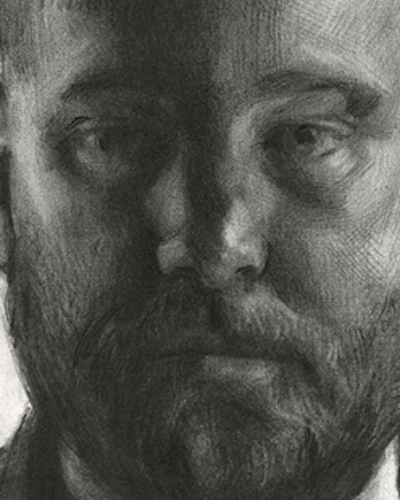Monday Mentors: Meet Evan Kitson, Model Coordinator
Monday, November 27th, 2023

Evan Kitson’s bio describes him as “a draftsman, painter, instructor, anatomist, curator, collector, and all-around art-obsessed thirty-something.”
You can add yet another descriptor, that of PCA&D Model Coordinator, to the list.
Working with human models is an integral part of an art and design education, and it falls to Kitson to keep the roster of life models robust, well-trained, and available for the College’s instructors to schedule.
This is the third academic year fulfilling this role for Kitson, a 2010 PCA&D graduate, “but before it existed I had been involved for about five years in a more volunteer capacity in giving model interviews and maintaining the model list,” he says. “I was honored to be asked to work with Fine Art Chair Becky Blosser to develop the Model Coordinator role and help to shape it to suit the needs of the PCA&D community as well as support our students in the classroom and the life models we collaborate with.”
(You can learn more here about PCA&D’s work with life models).
How is model recruitment or the model pool at PCA&D different than it may have been, say, 10 years ago?
Evan Kitson: We actively pursue new model leads by reaching out to life models in the greater Lancaster area to help keep our model list up to date; we’ve refined the interview process on the front and back end; I run model training sessions to help those interested in becoming figure models (as well as life models looking to refine their skill set) learn more about the practice and how we run our figure sessions here at PCA&D; and we are in contact every summer with the models on our list to keep it up to date for the fall semester. By keeping our model list up to date and adding to it each year as needed, we continue to ensure that it reflects our vibrant Lancaster-area community.
Are there any recent life model changes?
EK: The Foundation Department has been shifting their wonderful curriculum around and has created a really great figurative-focused course as an option for the students to take in the second semester — the other great option being a course that focuses on non-figural narrative.
What special challenges do you face in this role? What do you find especially rewarding?
EK: Getting to work so closely with our life models is really wonderful. From seeking out new models for the College, interviewing them to see if they’ll be a great fit for PCA&D, providing training to keep everybody confident in the studio, and then getting to actually collaborate with them in my courses: It’s all a real joy.
Is it accurate to say life modeling is a performance of sorts? It seems that life model work fits right in with your own creative practice; is that fair to say?
EK: Being a life model is absolutely performative. One of the things that sets great life models apart is an awareness and use of the theatricality of the practice. The students respond to it immediately, and it can really help carry a fun figure study session!
Yes, working with life models is a big part of my own creative process — my work often focuses on the human condition through portraiture and anatomical symbolism, and I make it a point to work with life models in my own studio as often as possible.
Interested in learning more about becoming a life model at PCA&D? Contact models@pcad.edu to see if you’d be a good fit for our programs.
